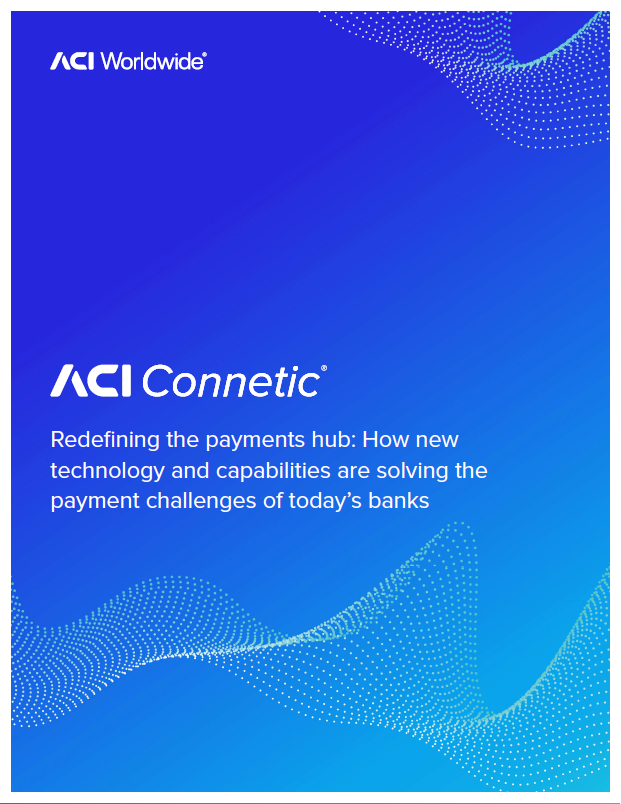- Solutions
- Banking
-
- ACI ConneticUnified cloud payments platform
- AcquiringDigital acceptance, merchant management
- IssuingDigital payments and accounts issuing
- Fraud managementReal-time enterprise fraud management
- RTGS / Wires and cross-borderMulti-bank, multi-currency processing
- Real-time, instant paymentsComplete real-time payments processing
- ATMsSelf-service, omnichannel digital experience
- Central infrastructureInnovative real-time payment infrastructure
- NEW Redefining the payments hub: Solving today’s banking payment challenges
-
- Merchant payments
- ACI Payments Orchestration PlatformEnable customer journeys across commerce channels, accept payments, prevent fraud and optimize your payments journey
- In-storeDynamic, modern in-store payments
- eCommerceOnline and mobile payments
- Alternative payment methodsGive more ways to pay
- Value-added servicesEngagement, optimization and reporting
- Fraud managementEnd-to-end fraud orchestration
- Risk, security, and complianceAchieve and maintain compliance
- NEW Datos names ACI Worldwide best-in-class in payments orchestration
- Industries we serve
- Billing and bill payments
- ACI SpeedpayDrive customer satisfaction with the widest range of bill pay options in the industry.
- Bill payment APIs and SDKsOutsource bill payment processing
- Fraud managementAI-based fraud orchestration technology
- Alternative payment methodsGive more ways to pay
- Loan servicingPreferred loan payment options
- Treasury managementStreamline and integrate your back office
- Automated debt collectionImprove your collections process
- Digital walletsManage digital cards and payments
- PCI compliance and securityAchieve and maintain PCI compliance
- Industries We Serve
- Fraud management and payments intelligence
- Fraud managementFraud solutions to minimize risk and prevent fraud
- Fraud management for bankingEnterprise-wide fraud prevention
- Anti-money launderingStay ahead of money-laundering schemes
- Robotic process automationAutomate payment processing operations
- Fraud management in the cloudProtecting your business in the cloud
- Fraud management for merchantsProtect payments from end to end
- ChargebacksPrevent chargebacks before they happen
- SCA complianceAchieve and maintain SCA compliance
- Digital identity solutionsConfirm identities with behavioral analytics
- NEW Scamscope fraud report: APP scam trends from around the globe
CompanyCustomersPartners
Home














ACI Worldwide and IBM: Powering the next generation of enterprise payments
ACI is optimizing Base24-eps and PRM for IBM’s latest Z platform to support major global financial institutions.

Meeting borrowers in a time of financial fragility
With auto debt at $1.66 trillion and many consumers now living paycheck to paycheck, lenders must adapt as financial stress grows.

Reflecting on Payments Unleashed 2025: A message from our CEO
Payments Unleashed 2025 was a milestone in ACI Worldwide's 50-year history, celebrating our legacy and setting the stage for future payments innovation.

Unlocking the power of PAR
Leveraging payment account reference numbers to overcome common merchant challenges.

Why merchant acquirers must embrace AI to stay competitive
Acquirers must move beyond incremental improvement, as the fraud and financial crime landscape continues to accelerate.

The UK’s renewed RTGS service is live, and why now is the time to rethink your CHAPS access
For senior banking professionals, the renewal is more than an operational milestone. It is a strategic inflection point.

Redefining the payments hub for a digital-first future
Discover how ACI Connetic is transforming payment infrastructures to meet the demands of modern banking

Sibos 2025: Showcasing ideas, not declaring change
Sibos 2025 signaled a shift toward proactive modernization, emphasizing practical tech integration and evolving regulations in banking.

Why insurance carriers shouldn’t be afraid to surcharge
With a high volume of transactions, even a small fee reduction can drive substantial and sustained cash flow improvements, cost savings, and improved profitability.

Bill pay isn’t what it used to be, and that’s a good thing
This transition didn’t happen overnight. It took years of innovation and careful integration to transform outdated payment systems into the modern, scalable, secure, and resilient platforms we use today.

Prep for peak season success with 3Ss: Stability, scalability, and security
The 2025 holiday shopping season requires merchants to prepare now for the golden quarter.

What you need to know about Visa’s new acquirer monitoring program (VAMP)
Visa’s newly launched Acquirer Monitoring Program (VAMP) is a significant shift in how fraud and dispute risks are measured and managed across the payments ecosystem.

The future of payments: Unlocking the power of payments orchestration
On this page Payments orchestration optimizes multiple payment processing providers and methods using a single, unified platform. Think of it as the conductor of an orchestra, ensuring each instrument plays its part harmoniously. This approach not only simplifies payment processing but also enhances overall efficiency and effectiveness.



